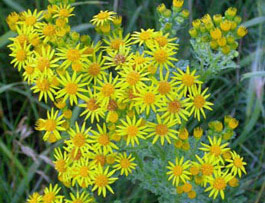Tansy Ragwort
Jacobaea vulgaris • Class B |
||
| Family Name: | Asteraceae family (ass-ter-AY-see-ee) | |
| Common: | Aster, daisy, or sunflower family | |
| Genus: | Jacobaea | |
| Species: | vulgaris | |
| Description: |
Tansy spends its first year in the rosette stage with dark green ruffled basal leaves. Rosettes usually overwinter and produce one or two flowering stalks in the next growing season. The plant grows to heights of between 2 and 6 feet. It develops a stout taproot from which numerous fibrous roots grow about 1 foot deep. The leaves are light to dark green and deeply lobed. The upper part of the stem is highly branched and bears up to 250 bright yellow, daisy-like flowers. Each flower has about 13 petals which helps to distinguish it from two other weeds that are similar in appearnce; St. John’s Wort, which has only 5 petals per flower, and Common Tansy, which has button-like flowers with no outer ray petals. |
| Why Is it a Noxious Weed? |
It is highly invasive and difficult to control. Tansy Ragwort is toxic to livestock. Its toxic alkaloids pose a threat to humans through food chain contamination. |
| Where Does it Grow? |
Tansy ragwort is a problem in grasslands, disturbed areas, forests, pastures, rangelands, and clear-cuts. Tansy ragwort occurs on many different soil types. |
| Facts: |
Tansy Ragwort contains pyrrolizidine alkaloids which lead to liver failure. This weed is toxic especially to cattle, horses, deer, pigs, and goats. |
| Control Options: |
|
| More Information: |
Download our Flyer or visit Washington State Noxious Weed Control Board Here. Photo by Leo Michels
|
| More Pictures: |
|
jacobaea (jak-koh-BAY-ee-uh) Meaning: Named for St. James (Jacobus), one of the Twelve apostles |







 Pierce County Noxious Weed Control Board • 9200 122nd St E, Puyallup, WA 98373 • 253-798-7263
Pierce County Noxious Weed Control Board • 9200 122nd St E, Puyallup, WA 98373 • 253-798-7263